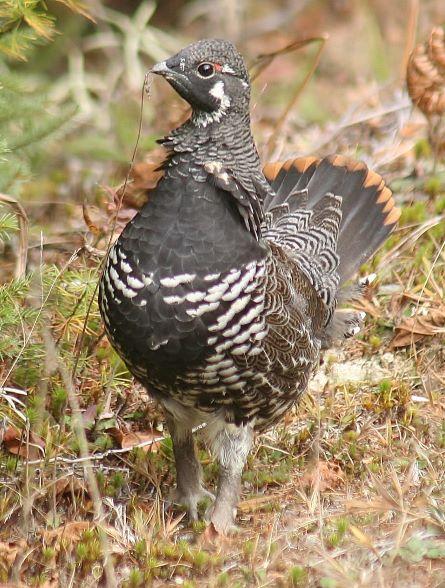- Tags:
- Something Wild,
- Wildlife

A male spruce grouse. (Photo: Robert A. Quinn, courtesy of NH Audubon)
New Hampshire has two species of grouse. You’re probably familiar with the ruffed grouse; it lives in woodlands throughout the state. But there’s another grouse found in the Granite State that few people have ever seen.
“Too bad the spruce grouse is so little known, because it’s got to be the most audacious of the gallinaceous,” says Dave Anderson, co-host of NHPR’s Something Wild. Gallinaceous refers to chicken-like birds, including both grouse and wild turkey.
“The spruce grouse seems almost tame, unconcerned when it encounters people,” says Something Wild co-host Chris Martin. “When you walk in the places where spruce grouse live, you don’t really find them, it seems more like they find you!”
Martin says to listen for a noisy whirring or fluttering of wings, and a rustling sound like sandpaper rubbing when the male fans his tail-feathers.
Spruce grouse have striking plumage, especially the males: red combs like giant fake eyelashes on top of the eyes, and dark brown and white stripes down the chest with a crazy quilt of brown patterns all over.
And look for this telltale sign: the chestnut brown tip of the tail on both male and female spruce grouse. Otherwise, the females might be mistaken for a ruffed grouse, but overall they're a much darker brown.
“Their color makes them concealable in those spruce fir forests.” says Jill Kilborn, nongame bird biologist for Vermont Fish and Wildlife. “But you put them in a northern hardwood stand and they'd probably stick out like a sore thumb.”
Kilborn was born and raised in Coos County, and saw plenty of spruce grouse in the 20 or so years she worked with N.H. Fish and Game in the North Country.
Spruce grouse are more common in eastern Canada. Here in the Granite State, the spruce grouse is truly a species living on the edge. Forest age and structure have created the ideal habitat for birds that are on the very southern edge of their range.
And here in the northeast, the edge of that edge occurs here in northern New Hampshire and northeastern Vermont.
In the White Mountains, they inhabit dense balsam fir and red spruce forests on mountain ridges above 3,000 feet where they can find their preferred diet of spruce and fir needles, especially in winter.
Spruce grouse also inhabit lowland bogs and sphagnum-covered woods scattered across the Androscoggin River Valley.
It turns out that spruce grouse are really particular about which spruce and fir forests they prefer, says Kilborn. “They like 20-50 year old spruce and fir stands that have lots of branching all the way down to the forest floor, and have dense structure that they can hide in,” she says.
This also allows for vegetation to grow on the forest floor where they can find bugs, blueberries, fungi or other things they like to eat.
Spruce grouse ultimately benefited from an outbreak of spruce budworms in New Hampshire that ended in 1983. Spruce budworms are the larvae of a native moth that tend to recur in a 40 year cycle. Subsequent salvage logging regenerated an ideal forest for spruce grouse: lush young spruce and balsam thickets.
Spruce grouse like trees with lots of low branches. They often move around the woods by walking from tree to tree on the interlacing branches. “So you'll often see them hopping from branch to branch, kind of picking around in those trees at that mid-canopy layer,” says Kilborn.
“Spruce grouse will do a mating display in the spring,” says Kilborn, “where they'll start on the forest floor, and then fly up to a low hanging branch and then fly back down to the forest floor. It's kind of this flight pattern. They also do this kind of side flutter shuffle on the forest floor as well.”
With their preferred forests specifically adapted to cold temperatures, spruce grouse could be pushed farther north in the future. And with less snowfall and more freeze-thaw cycles, it potentially exposes grouse to a wider variety of predators.
“Shallower snow depth allows different species that typically can't be in those snowy places to be there essentially the whole winter,” says Kilborn. “That puts predation pressure on spruce grouse.”
The spruce grouse is emblematic of species that live in northern zones and forests, like moose, marten and lynx. With a warming climate, it's particularly important to monitor for changes in these populations and their forest habitats.
